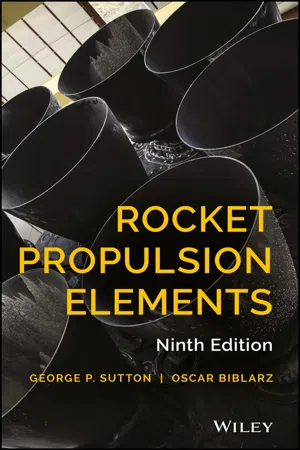
Rocket Propulsion Elements
George P. Sutton, Oscar Biblarz
- English
- ePUB (disponibile sull'app)
- Disponibile su iOS e Android
Rocket Propulsion Elements
George P. Sutton, Oscar Biblarz
Informazioni sul libro
ROCKET PROPULSION ELEMENTS
THE DEFINITIVE INTRODUCTION TO ROCKET PROPULSION THEORY AND APPLICATIONS
The recent upsurge in global government and private spending and in space flight events has resulted in many novel applications of rocket propulsion technology. Rocket Propulsion Elements remains the definitive guide to the field, providing a comprehensive introduction to essential concepts and applications. Led by industry veteran George P. Sutton and by Professor Oscar Biblarz, this book provides interdisciplinary coverage including thermodynamics, aerodynamics, flight performance, propellant chemistry and more.
This thoroughly revised ninth edition includes discussion and analysis of recent advances in the field, representing an authoritative reference for students and working engineers alike. In any engineering field, theory is only as useful as it is practical; this book emphasizes relevant real-world applications of fundamental concepts to link "thinking" and "doing". This book will help readers:
- Understand the physics of flight and the chemistry of propulsion
- Analyze liquid, solid, gas, and hybrid propellants, and the engines they fuel
- Consider high-temperature combustion, stability, and the principles of electric and chemical propulsion
- Dissect the workings of systems in common use around the world today
- Delve into the latest advances in materials, systems, propellants, and more
Broad in scope, rich in detail, and clear in explanation, this seminal work provides an unparalleled foundation in aerospace engineering topics. Learning through the lens of modern applications untangles complex topics and helps students fully grasp the intricacies on a more intuitive level. Rocket Propulsion Elements, Ninth Edition merges information and utility building a solid foundation for innovation.
Domande frequenti
Informazioni
CHAPTER 1
CLASSIFICATION
| Energy Sourcea | ||||
| Propulsion Device | Chemical | Nuclear | Solar | Propellant or Working Fluid |
| Turbojet | D/P | Fuel + air | ||
| Turbo–ramjet | TFD | Fuel + air | ||
| Ramjet (hydrocarbon fuel) | D/P | TFD | Fuel + air | |
| Ramjet (H2 cooled) | TFD | Hydrogen + air | ||
| Rocket (chemical) | D/P | TFD | Stored propellant | |
| Ducted rocket | TFD | Stored solid fuel + surrounding air | ||
| Electric rocket | D/P | D/P | Stored propellant | |
| Nuclear fission rocket | TFD | Stored H2 | ||
| Solar‐heated rocket | TFD | Stored H2 | ||
| Photon rocket (big light bulb) | TFND | Photon ejection (no stored propellant) | ||
| Solar sail | TFD | Photon reflection (no stored propellant) | ||